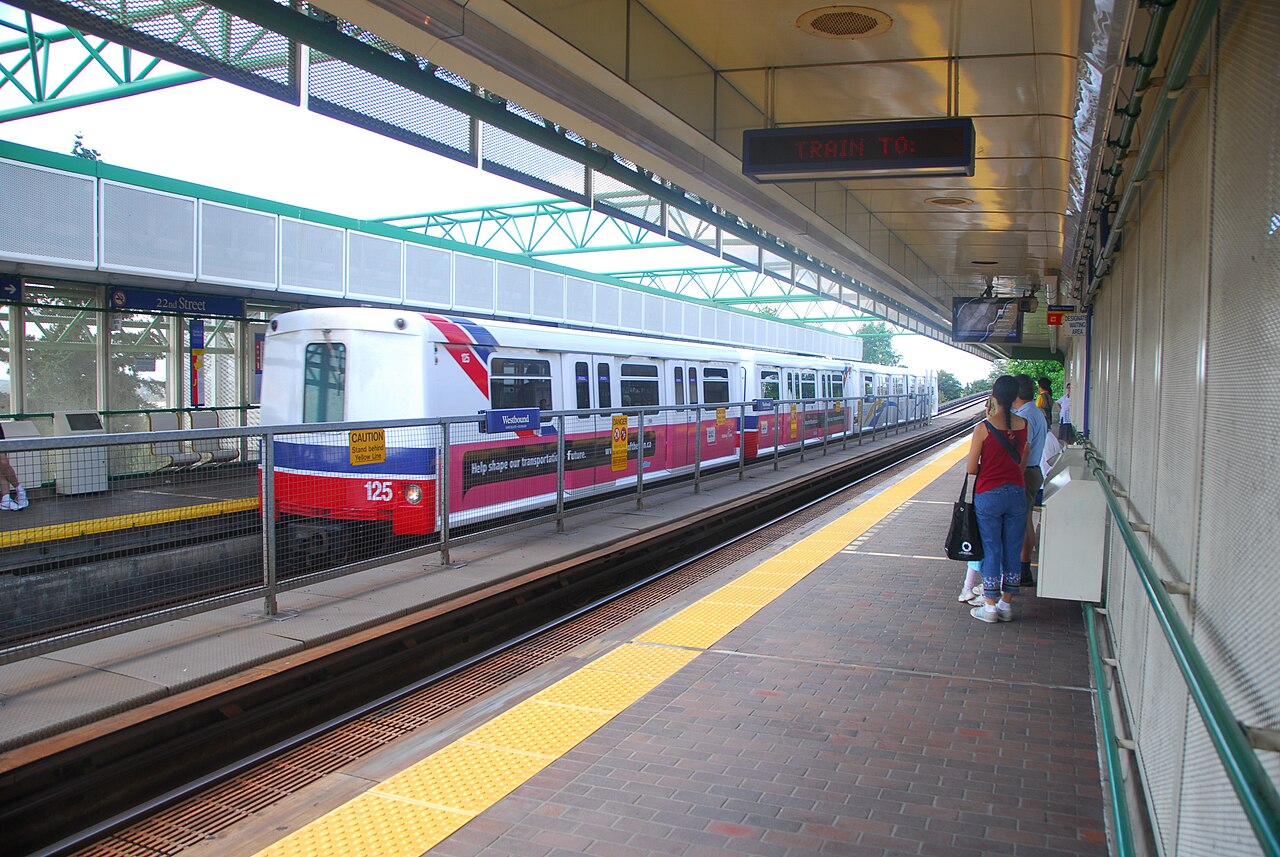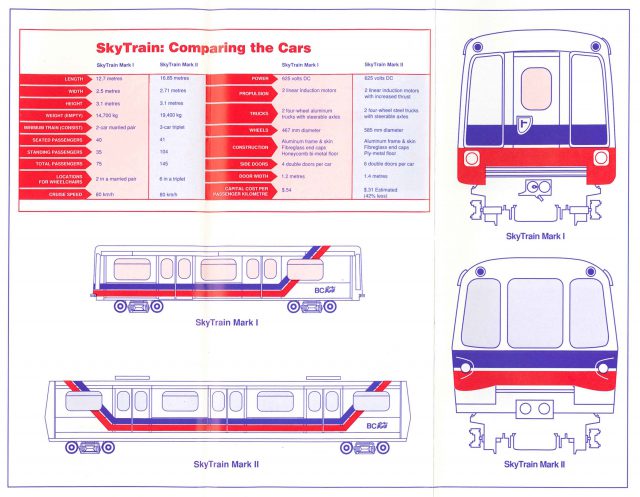So, we have here people using the ICTS technology for Hamilton, Vancouver, Toronto, Ottawa and Detroit, where else in Canada could this have been used? Calgary and Edmonton have extensive LRT systems (and were pioneers in the technology in North America, plus both were building their systems before the ICTS was finished development) so they're out, but are there any other options?
Winnipeg is the big and obvious one. The southwest Transitway would have looked a lot like other ICTS proposals, and much of what would otherwise make sense there would work very well elevated.
Edmonton is really obvious (bear in mind that it was one of the few genuinely serious post-war proposals for a heavy rail system that didn't build anything), except for the big and dual problems of the project being almost a full decade too early for ICTS to be on the radar and closely tied to the 1978 Commonwealth Games.
Calgary WOULD make a lot of sense, but the whole ethos there seems to have been reproducing Edmonton on the cheap... and in AH terms I kind of hate to attack what really ought to be seen as the single best example of what modern LRT can be. IMO the only failure of Calgary that is really significant enough to be heavily noted in terms of other cities taking lessons is that the downtown tunnel should be DISCUSSED more than it is... even if it may still be genuinely reasonable to put it off another decade.
In short, I'll say that while I really do love light metro and think it's the closest thing we have to a single 'best' form of urban rapdid transit, good high floor light rail on mostly railway like right of ways (of the type Reece Martin would call a 'City Train') is a very a close second (and Australian style mainline compatible rail operating quasi metro services probably ranks next, albeit a good way down, but a bit above an actual metro line unless you're a genuine metropolis).
Quebec City, perhaps? If they can make the ICTS go up the Escarpment the difference between old Quebec City and the new one would be doable as well.
Yes, QC is very much a good candidate. Frankly I suspect that bringing CDPQ into their (current, OTL) tram planning will end with them dropping the east/west plan and turning the new tunnel into a REM line.
The Buffalo idea is neat and very logical, though I'm not sure Buffalo has the transit ridership to justify it without expanding their bus network considerably. But if that can work it's a good idea. The LAX People Mover is also a similarly good idea.
Buffalo actually has incredibly good ridership on a per mile basis, though how much that can be credited to it having a line that is really a a full metro in all but name is a fair question.
LAX aside, remember that LA had THE, singular, downtown peoplemover that was closest to construction without actually happening, and had committed to ICTS by cancellation. Good maps of the proposal are few and far between so I did one in Google:
I'd take particular note that this would have been a very nice terminal if the Blue Line changed modes, have genuinely functioned as well as a downtown distributor could be asked to, and would have been incredibly well positioned for a tunneled extension to Dodger Stadium.
I have to wonder whether a successful LA peoplemover might have been enough to get Jacksonville to go ICTS when they abandon VAL. For all the Skyway's faults ICTS would clearly have them on a better footing than they are now...
AFAIK Milan is the only other real project that was anything but an incredibly high level look by UTDC which would have used Mk Is, and is IMO interesting for that alone, even if we are mostly interested in NA.
Looking at the US, there are a few places where the dates and ridership line up to where an earlier (and thus less expensive) ICTS system might be possible. Sacramento, San Jose, Denver and Salt Lake City are possible converts from Light Rail-based systems and Miami is an easy one for its Metrorail system, particularly considering the cost of the Metrorail system and its mismanagement of it.
The Texan systems also come to mind, but truthfully I'd suggest that the North American light rail systems that
wouldn't be better served by some form of light metro, ICTS or otherwise, are few and far between. And probably best represented by the likes of the genuinely successful streetcars (which means, imo, the surviving legacy systems, Portland, Oklahoma City and little else)... Even considering Denver though, the single most infuriatingly close system is Seattle, between geographical proximity to Vancouver and OTL's line being so close to full grade separation.
Baltimore IS also probably worthy of special consideration... as much as I love the concept of an AH that builds the subway out to BWI and eventually through routes the Baltimroe and Washington Metros, it's kind of silly (if exactly the kind of thing that might happen if the right set of politicians get excited by the aesthetics). Light Metro on the other hand is better suited to the demand levels on the existing subway, the distances involved in the existing light rail, while the red line is up there with Seattle and Ottawa in terms of lines that are annoyingly close to metro standards being turned into LRT. While I'm thinking of Maryland, as much as the Purple line is mostly street level it's clearly a line better suited to autpmation than trams, and in an environment that elevated guideways wouldn't be especially problematic for.
Looking for other potential projects in Canadian terms:
The south shore REM line was kicking around for a long time prior to CDPQ, and there were plenty of renders over the years with Mk IIs.
It's a bit of a stretch, but I really do like on a conceptual level what ION could have looked like if built with ICTS. Also maybe not completly unreasonable in a timeline premised on ICTS becoming something of a Canadian default.
Niagara Falls is probably one of those few things that really does work better as a streetcar, but ICTS is actually probably closer to what was in mind when the Parks Commission was looking at fixed guideway a decade or two ago. My take, albeit drawn for streetcars was:
Paging through cities (that didn't instantly come to mind otherwise) by population:
A north/south Oshawa corridor linking the GO/VIA station, mall and UOIT has a lot to be said for it, doubly so if ALRT is in place.
I've semi seriously toyed with what London's rapid transit plans would look like in light metro form, and ended up with something I quite like:
I grant that the elevated path through the core might be a bit of a stretch, but this is still pretty good if you assume it has to be tunneled all the way south to the train station.
There's never been any real talk of anything heavier than an LRT on the tram side of the spectrum for Victoria, but there's also nothing about the East/West corridor that makes ICTS especially difficult for it... and if one looks to the Saanich peninsula speed really is key to making transit attractive (although my quasi professional opinion is that the Saanich is unbelievably well suited to an Ottawa style BRT).
I've mused here in the past that the Saanich might be a place either... well suited, or particularly vulnerable to... gadbetbahn salesmen pitching the stability of monorails in terms of suitability for a pontoon crossing at the north end. A nonsensical concept OTL, but the possibilities in Victoria do start to get interesting in any TL that boosts the population significanlty (which imo isn't hugely difficult given the engineering realities of a fixed link to the Island somehwere north of Cambpell River).
To put a weirder idea of mine out there, as much as ICTS proper was meant as an urban system and it IS a ~150 km long, the Penticton - Kelowna - Vernon - Armstrong corridor has a lot to be said for it, and just enough obstacles to make mainline rail genuinely hard to do. It's probably best suited to a pretty traditional interurban, but not entirely something I'd discount (especially if ALRT is a thing) if Canada got really aggressive building out fixed guideway systems.
And of course there's always the really obvious suitability of Hurontario for light metro over LRT.
PS:
Even setting aside TV06 and it's potential to show up for day 0, Vancouver's early interest in a larger train had Mk II concepts kicking around from very early.
In a timeline where Vancouver grew it's system aggressively from a very early stage it would definitely be aesthetically pleasing to have the Mk II show up early and in a form more clearly related to the Mk I.

